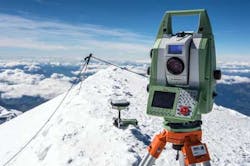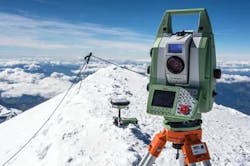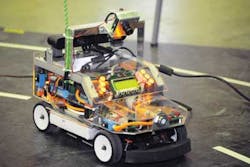May 2014 Snapshots: 3D scanner maps Europe's highest peak, graphene detector, shark's eye view camera, vision for self-steering car
A team of surveyors from multiple organizations recently made a journey to the top of Europe's highest peak, Mont Blanc, to take the first ever 3D laser scan of the shape and volume of the mountain's ice cap. Surveyors from Leica Geosystems France (Le Pecq, France;www.leica-geosystems.fr) and chartered land surveyors of the upper Savoy region of France were accompanied by technical partners from Géomédia (Brest, France; www.geo-media.com) and Teria (Bourg-la-Reine, France, www.reseau-teria.com), guides, a photographer, and a cameraman.
After reaching their destination, the team set up their equipment as quickly as possible, withstanding a 10°F temperature.
A Leica Viva GS24 antenna was used to take altitude measurements and another GS14 antenna was used to calculate the volume of the ice cap. Lastly, a Leica Nova MS50 MultiStation laser scanner performed 3D laser scanning of the ice cap.
Nova MS50 MultiStation scanners feature an onboard 3D point cloud viewer. In addition, the scanner features a 5 MPixel CMOS image sensor with a maximum frame rate of 20 fps.
It features a scanning speed of 1,000 points/s, target acquisition with 20 Hz live video stream, automatic focusing, and 30x magnification for target acquisition.
MS50 scanners also feature RS232, USB, Bluetooth, and WLAN interfaces, an operating temperature range of -4-122°F, and an IP65 enclosure.
Point cloud data acquired by the scanner was sent to expedition partner Géomédia where its Covadis software calculated the volume of 20,213 m³ of the ice cap covering the summit and also produced a 3D animation of the scan data.
The last time an altitude measurement of Mont Blanc was made a measurement of 4,807m was recorded. Following this latest expedition, an altitude of 4,810.02m was calculated.
Graphene detector images the IR spectrum
Engineering researchers from the University of Michigan (Ann Arbor, MI, USA;www.umich.edu) have developed a detector made of graphene that images the infrared spectrum.
To make the device, they placed an insulating barrier layer between two graphene sheets with the bottom layer having a current running through it. When light hit the top layer, it frees electrons, creating "holes" that act as positive charges. The positively-charged holes, left behind in the top layer, produce an electric field that affects the flow of electricity through the bottom layer. By measuring the change in current, the brightness of the light hitting the graphene can be deduced.
This approach allows the sensitivity of a room-temperature graphene device to compete with that of cooled mid-infrared detectors.
The research team has already produced an infrared sensor the size of a contact lens, according to Zhaohui Zhong, assistant professor of electrical and computer engineering at the University.
Such a device would obviously not require cooling equipment, but would work equally as well as a cooled mid-infrared detector according to the researchers.
The research was supported by the National Science Foundation (Arlington, VA, USA;www.nsf.org), and published online in the journal Nature Nanotechnology.
Cameras provide shark's-eye view of the ocean
By attaching GoPro video cameras and sensors to a number of sharks, researchers from the University of Hawaii at Maˉnoa (Honolulu, Hawaii;www.manoa.hawaii.edu) and the University of Tokyo (Tokyo, Japan; www.u-tokyo.ac.jp/en) have gained insight into their feeding, social interaction, and swimming patterns.
Scientists from both universities mounted video cameras on the fins of reef sharks in Hawaii to provide more information on the ocean predators. This includes information on where they are and what they do after reaching their destination.
"We are trying to detail what the role of the shark is in the ocean," said Carl Meyer, an assistant researcher at the University of Hawaii at Manoa. "It is about providing an understanding of the shark's ecological role in the ocean, which is important to the health of the ocean and, by extension, to our own well-being".
In addition, the researchers are using instruments ingested by the sharks to make electrical measurements to track ingestion and digestion or prey, to help understand where, when, what, and how much sharks and other sea predators are eating.
One of the more interesting observations made by the video cameras was that of sharks of different species swimming together in schools and interacting with other fish and moving in repetitive loops across the sea floor.
Vision Systems Articles Archives
GigE camera provides vision for self-steering car
A team from the University of Ulm (Ulm, Germany;www.uni-ulm.de/en) has used a board-level GigE camera in its Spatz 5 vehicle, which took home the top prize from the University of Brunswick – Institute of Technology's (Braunschweig, Germany; www.tu-braunschweig.de/index.html) annual Carolo Cup miniature autonomous vehicle competition.
Spatz 5 was one of many student-designed autonomous vehicles that competed in the annual Carolo Cup race and competition. Vehicles are judged for the ability to pass, stay in the lane, mind stop lines, and park correctly in a 70cm parking space. To image scenes, the students installed a Baumer (Radeberg, Germany;www.baumer.com) MXG02 board level camera in the Spatz 5 to detect the course of the road and road markings.
Baumer MXG02 cameras feature 1/4in progressive scan Sony ICX618 CCD image sensors with a 5.6 µm x 5.6 µm pixel size. The cameras also feature a GigE interface, 120 MB internal buffer, and free running and trigger synchronization. The 656 x 490 pixel cameras achieve a frame rate of 160fps at full resolution, which Martin Bach, the team member in charge of imaging said enabled the vehicle to keep its course on the track.
Vision Systems Articles Archives




